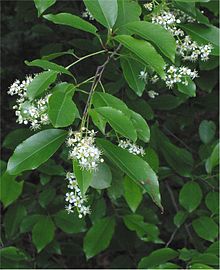Black cherry
| Prunus serotina | |
|---|---|
 |
|
| Flowers and leaves | |
| Scientific classification | |
| Kingdom: | Plantae |
| (unranked): | Angiosperms |
| (unranked): | Eudicots |
| (unranked): | Rosids |
| Order: | Rosales |
| Family: | Rosaceae |
| Genus: | Prunus |
| Subgenus: | Padus |
| Species: | P. serotina |
| Binomial name | |
|
Prunus serotina Ehrh. 1784 |
|
 |
|
| Natural range | |
| Synonyms | |
|
Synonymy
|
|
Prunus serotina, commonly called black cherry, wild black cherry, rum cherry, or mountain black cherry, is a deciduous woody plant species belonging to the genus Prunus. The species is widespread and common in North America and South America.
Black cherry is closely related to the chokecherry (Prunus virginiana); chokecherry, however, is classified as a shrub or small tree and has smaller, less glossy leaves.
Black cherry is a medium-sized , fast-growing forest tree growing to a height of 50-80 feet. Leaves are 2" to 5" in length, ovate-lanceolate in shape, with finely toothed margins. Fall leaf color is yellow to red. Flowers are small, white and 5-petalled, in racemes 4" to 6" long which contain several dozen flowers. The flowers give rise to edible reddish-black "berries" (drupes).
A mature black cherry tree can easily be identified in a forest by its very broken, dark grey to black bark, which has the appearance of very thick, burnt cornflakes. However, for about the first decade or so of its life, the bark is thin, smooth, and banded, resembling that of a birch. It can also quickly be identified by its long, shiny leaves resembling those of a sourwood, and by an almond-like odor released when a young twig is scratched and held close to the nose.
Prunus serotina is a pioneer species. In the Midwest, it is seen growing mostly in old fields with other sunlight-loving species, such as black walnut, black locust, and hackberry. Gleason and Cronquist (1991) describe P. serotina as "[f]ormerly a forest tree, now abundant as a weed-tree of roadsides, waste land, and forest-margins." It is a moderately long-lived tree, with ages of up to 258 years known, though it is prone to storm damage, with branches breaking easily; any decay resulting, however, only progresses slowly. Seed production begins around 10 years of age, but does not become heavy until 30 years and continues up to 100 years. Germination rates are high, and the seeds are widely dispersed by birds who eat the fruit and then excrete them. Some seeds however may remain in the soil bank and not germinate for as long as three years. All Prunus species have hard seeds that benefit from scarification to germinate (which in nature is produced by passing through an animal's digestive tract).
...
Wikipedia
